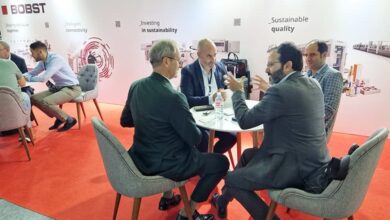The signage and graphic industry’s top companies from the local regional and international markets spanning 34 countries will converge in Dubai in January 2016 for the SGI Dubai show, the largest exhibition of its kind in the Middle East. Over 400 global and regional exhibitors will unveil the industry’s top and latest printers and equipment worth AED220 million.
The 19th edition of SGI Dubai expects to receive over 12,000 visitors from 78 countries and they are set to witness the industry’s latest products and trends. International Expo Consults (IEC) stated that one of the reasons for global exhibitors setting their sights on this region is due to the forecasted 7.2% revenue growth in the printing industry per annum.
Ashish Panjabi, Chief Operating Officer of UAE-based company Jacky’s Business Solutions, said, “We have been participating at SGI Dubai since 2001 and as the largest show of its kind in the Middle East, it has been a key launching ground for us to introduce our newest products in the signage and advertising industries.”
For the last 18 years, SGI played a role in being a concurrent base for stakeholders, exhibitors and visitors in the signage and graphic industry to converge. The exhibition serves as a meeting point for print and production manufacturers, sign makers, media and marketing agencies, developers, architects, and brand and image consultants, among others.
“SGI Dubai 2016 is spread across a larger floor space and is much bigger than its previous editions. The exhibitors and visitors can expect to witness the best-kept secrets in the industry from across the globe,” says Abdul Rahman Falaknaz, Chairman of IEC.
Mr. Nayyar Ansari, Business Development Manager Production Printing at Konica Minolta, said, “We feel that the SGI Dubai is the right platform to showcase our range of award winning digital SRA3 PRESS’s for the commercial production print market. We look forward to network with key local, regional and international business partners.”
Aside from the region’s rising number of projects and developments, the growth drivers today are its retail, tourism, and hospitality industries.
“We at Sawgrass are delighted to present the first fully integrated 8-color sublimation system of this size at SGI Dubai,” says Darcy Mauro, President of US-based Company Sawgrass. “Sawgrass will also showcase the newly-launched Virtuoso HD Garment Decorating System; the industry’s first and only fully integrated system designed specifically for cotton transfer printing. There will also be scheduled demonstrations at our booth.”
IN this year SGI car wrapping is also takes the centre stage. UAE’s car wrapping industry is set to grow further in the UAE due to the large presence of creative car enthusiasts in the UAE. As per reports, vehicle wraps can increase business by an amazing 107% for some companies. IEC stated that in 2016, several businesses small and large will continue to turn to car wraps as one of the best, most cost-efficient forms of branding and advertising. SGI Dubai 2016 will have a dedicated area for car wrapping, to display the sector’s latest technology and trends.
“We have seen a growing trend, whether it is to celebrate the country’s National day or for advertising purposes the cars and vehicles are getting transformed with creative car wraps. This trend is more popular in US and European markets. However, this is fast catching up in UAE and other countries in the region. Car enthusiasts are seeking to customize their personal vehicles with full vehicle wraps. Typically, people turn to car wraps to make their cars stand out from the crowd with unique colors and finishes, as car manufacturers today only offer a limited selection of colors. With more awareness about the versatility and convenience of car wraps, more consumers will undoubtedly turn to this method of personalizing one’s vehicle,” stated Mr. Sharif Rahman, CEO, International Expo Consults – Organisers of the SGI Dubai show.
Al Futtaim motors has been supporting this section of the SGI Dubai show by providing the latest Jeeps to demonstrate this technology. Several exhibitors with car wrapping expertise, including Signtrade International, Strings International, and System Middle East, among others, will be revealing their car wrapping product portfolios and services.
“Automobile fans will revel in the car live wrap displays we’ll be exhibiting at the event, especially those vehicle owners on the lookout for ideas to make their cars one-of-a-kind. In addition, those who are looking into car wrapping as a form of outdoor advertising will also gain numerous insights and can network with potential suppliers and experts. Wrap advertising acts as a mobile billboard, making it easier to target a wider proximity of a brand’s target market. It is an impressive addition to a brand’s integrated marketing strategy,” added Mr.Rahman.
The Grand View Research study also found that car wraps’ popularity will expand well outside the US throughout the next few years. From major industrial nations like China and Germany to places like India, Indonesia and Vietnam, car wraps will become an increasingly global phenomenon. This form of advertising is experiencing a rapid growth, promoting brand recognition 15 times better than other advertising platforms. The growth is also supported by UAE’s automobile industry advancement and growth in outdoor advertisements.
Consulting firm Frost & Sullivan estimated that the car wrapping industry generated USD220-250 million at the retail level few years ago, also assessing that the vehicle wrapping industry will experience a 10 percent year-on-year market growth. WhaTech, a global IT source, also predicted the future of car wrapping by 2020: increased customization of personal and business automobiles, growing demand for businesses, and adaptation in other countries.
“UAE is one of the best places in the globe for automobile aficionados. In the past few years, the UAE has been witnessing the fast-paced growth of the car wrapping industry and graphic customization. Car wrapping was originally designed for advertising purposes but its ability to inject uniqueness to a vehicle also increased its demand. Its process involves covering every inch of the vehicle in a vinyl wrap,” added Mr. Rahman.
SGI Dubai 2015, an official DSF event welcomed over 400 global exhibitors from across 34 countries and registered over 12,781 trade visitors from 78 countries during the three days during January this year The ‘SGI Dubai 2016’ show will be held from January 10th to 12th at the Halls 3, 4, 5, 6, 7 and 8 at the Dubai World Trade Centre.





